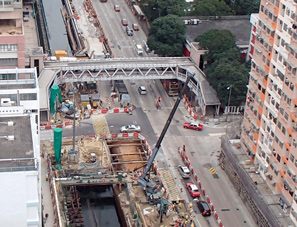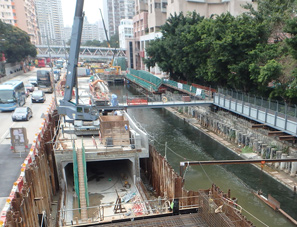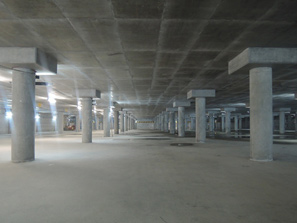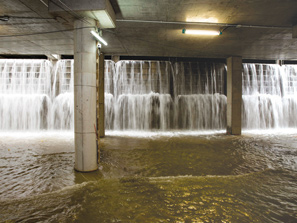Overview of Flood Prevention in 2015-16
To safeguard the general public against flooding, we have designed and constructed stormwater drainage systems with reference to international standards, and carried out regular inspections and timely maintenance works. In 2015, Hong Kong recorded a scant 1,874.5 millimetres in total rainfall, which was some 22% lower than the annual average of approximately 2,400 millimetres between 1981-2010. In 2015-16, the Hong Kong Observatory issued one Black, three Red and 14 Amber Rainstorm Warnings. Despite the comparatively low rainfall recorded in this wet season, the incidence of extreme precipitation events posed challenges to flood prevention. The Amber Rainstorm Signal on 22 July 2015, which lasted nearly 12 hours, was one of such cases in which West Hong Kong Island saw over 300 millimetres of rainfall. In the morning of 7 October 2015, in the absence of Rainstorm Warning Signals, parts of the New Territories East were inundated with torrential rain, with over 150 millimetres recorded in Sai Kung. Another uncommon event was the Amber Rainstorm Warning issued on 5 January 2016, which was the first Rainstorm Warning ever issued in January since the Rainstorn Warning System was established.
In 2015-16, DSD continued to implement various flood prevention projects in order to boost the flood protection levels and reduce flooding risks in relevant areas. In addition to ensuring that our facilities are operated properly, we are also reviewing the Drainage Master Plans (DMPs) of various districts in stages, so as to formulate corresponding strategies for Hong Kong’s future development.
Eliminating Two More Flooding Blackspots
Having evaluated the effectiveness of completed drainage improvement works in early 2016, we eliminated two more flooding blackspots at Ping Kong, Sheung Shui and Nam Wa Po, Tai Po which brings the total number of flooding blackspots down from ten to eight.
Sewage Services Branch
Among the eight remaining flooding blackspots, drainage improvement works for three of them have been commissioned. We are monitoring the effectiveness of these works and the relevant flooding blackspots will be eliminated in due course as appropriate. Improvement works is under way for another blackspot, and planning and design are under way for the rest. In the meantime, we will closely monitor the drainage condition in these areas during the rainy season and do our best to eliminate all of them as soon as possible.
Operating, Repairing and Maintaining Existing Drainage Facilities
DSD manages 2,400 kilometres of underground stormwater drains, 360 kilometres of manmade waterways, and 36 stormwater pumping stations. In 2015-16, we continued to carry out regular inspections and preventive maintenance works for our stormwater drainage facilities to ensure smooth operations of the drainage systems. We also conduct regular functional and structural checks and clear blockages before the wet season and after heavy rainstorms. Last year, we inspected over 2,000 kilometres of drains and rivers.
![]()
Emergency and Response
- The “Emergency and Storm Damage Organisation” (ESDO) handles emergencies and flooding incidents all year-round
- The Emergency Control Centre will be activated in the event of an emergency in order to coordinate emergency clearance tasks for blocked stormwater drains and rivers in Hong Kong; respond to flooding reports; share flooding information within the government; and issue flooding-related messages and warnings to the general public when needed
![]()
Stormwater Storage Schemes
- Diverting stormwater to underground storage tanks for temporary storage during heavy rainstorms to relieve the burden of downstream drainage systems. Stormwater storage schemes at Tai Hang Tung, Sheung Wan and Happy Valley (Phase 1) are now in operation
![]()
Drainage Tunnels
- Intercepting stormwater on higher ground at upstream, diverting and directly discharging to the sea or into rivers, thereby substantially mitigating flooding risks in downstream areas
- Four drainage tunnels, including Kai Tak Transfer Scheme, and Hong Kong West, Lai Chi Kok and Tsuen Wan Drainage Tunnels, totaling about 21 kilometres in length, are now in operation
![]()
Village Flood Protection Schemes
- Constructing embankments around low-lying village and Building flood storage ponds and stormwater pumping stations in villages for temporary storage of stormwater during heavy rainstorms and subsequent discharge by pumping
- 27 Village Flood Pumping Schemes are currently in operation, providing flood protection for 35 low-lying villages
Planning, Design and Construction of New Drainage Facilities
DMP Reviews
Since its establishment, DSD has completed eight DMP studies and three Drainage Studies, covering all flood-prone areas in Hong Kong. We review and update DMPs in a timely manner to assess the effectiveness of completed drainage improvement works, in order to tie in with the latest development in the city and adapt to climate change. Where necessary, we will recommend further improvement measures.
Current Progress
The review studies of DMPs for Yuen Long district, Northern New Territories and Happy Valley were completed in 2011, and the improvement works proposed in the studies are under construction or design. DMP Reviews of the West Kowloon and the East Kowloon were also completed in 2015. We are currently reviewing the DMPs for Lantau and Outlying Islands, Sha Tin and Sai Kung ;Tai Po; and Northern Hong Kong Island. Planning for the remaining review studies is underway.
In 2015-16, we made further progress in the following major flood prevention projects:
Kai Tak River Improvement Works
The project aims to improve flood protection levels of East Kowloon by reconstructing and rehabilitating a 1.1-kilometre section of the Kai Tak River from Po Kong Village Road to Prince Edward Road East. A box culvert of about 400 metres long will also be constructed alongside the river upstream. We hope to ride on the opportunity to upgrade the river’s flood relief capacity and revitalise it as a green river corridor for public enjoyment.
Current Progress
Upstream and midstream improvement works of Kai Tak River commenced in October 2011 and December 2013 respectively, with anticipated completion by stages by the end of 2017. The project estimate is about $2.8 billion.
Shenzhen River Regulation Project Stage IV
Shenzhen River Regulation Project Stage IV is designed to enhance flood protection levels for the river section between the Ping Yuen River estuary and Liantang/Heung Yuen Wai Boundary Control Point to withstand rainstorms of a 50-year return period. The project includes improvement works of a 4.5 kilometres section of the Shenzhen River (between Ping Yuen River and Pak Fu Shan), and construction of a flood retention lake of 80,000 cubic metres. Wetland plants for water purification and scenic purposes will be planted. Along with riverbank greening elements, these features will enrich the ecology of Shenzhen River.
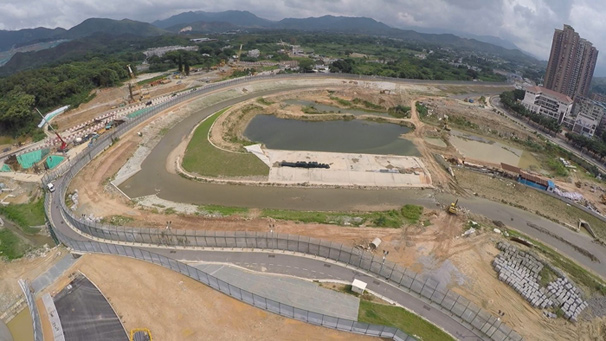
Bird’s-eye view of Shenzhen River Regulation Project Stage IV (construction of retention lake in progress)
Current Progress
Shenzhen River Regulation Project Stage IV is slated for completion in 2017 at an estimated construction cost of approximately $1 billion.
Happy Valley Underground Stormwater Storage Scheme
To alleviate the flood risks in Happy Valley and Wan Chai districts, we initiated the Happy Valley Underground Stormwater Storage Scheme (HVUSSS) in 2012, constructing an underground storage tank with a total capacity of 60,000 cubic metres, a box culvert of about 650 metres, and a stormwater pumping room rated at a peak flow of 1.5 cubic metres per second. It is the first flood prevention project in Hong Kong with a movable crest weir system and a Supervisory Control and Data Acquisition (SCADA) system.
Current Progress
Phase 1 of HVUSSS was commissioned in March 2015. The three football pitches above the tank were reinstated and are now open to the public. The project team aims to complete the underground storage tank in Phase 2 before the 2017 wet season. Once the project is commissioned, the flood protection level of the region will be able to withstand rainstorms of a 50-year return period. The estimated cost for the entire project is about $1 billion.



